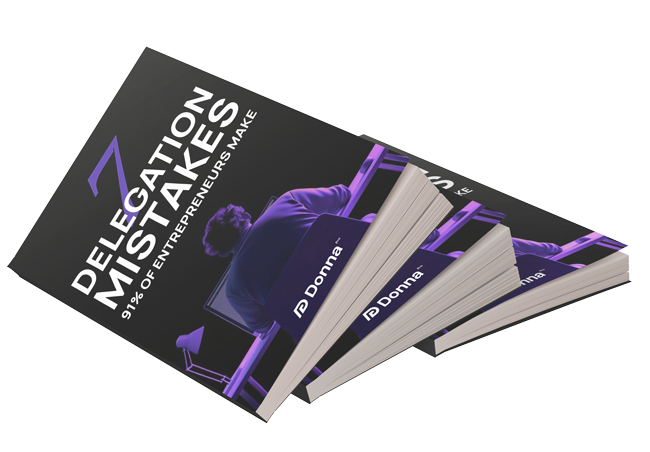6 Steps For CEOs To Go From Chaos To Growth in 2025
For many CEOs and founders, chaos feels inevitable.
Your days are packed with back-to-back meetings, endless emails, and a mountain of tasks that only seem to grow.
You know you should be focusing on scaling your business, streamlining workflows, and driving growth – but instead, you’re stuck putting out fires.
How do I know this?
Because I’m Donna.
An executive assistant with one job – to make life easier for leaders.
I may not be a CEO or founder myself, but for the past years, I’ve worked closely with some of the best leaders in the European Union…
And trust me, I’ve seen it all: CEOs swamped with endless to-do lists, stretched too thin to focus on the big picture, and frustrated by how little time they have for actual growth.
The truth is, chaos probably feels like the default mode for you – but it doesn’t have to be.
You can escape the daily grind, reclaim your time, and still maintain control over your business (I’ve seen it happen many times, and actively helped leaders get there)…
So today, I’ll share what I’ve learned, and what worked best for other CEOs.
These 6 steps are used by some of the best business owners in the European Union, and they might just help you go from chaos to growth in 2025.
Step 1: “Level-Up” Your Vision

Yes, I know… “Your company needs a vision” is some of the most overplayed, generic business advice out there.
You’ve heard it before, you’re probably tired of it – and let’s face it, you already have a vision for your business.
So let’s skip the clichés and dive into what makes a truly next-level vision (one that can inspire your team to follow you religiously enthusiastically).
You see, the best CEOs told me, that there’s a difference between having a truly powerful vision, and just stating something to be politically correct…
Take NASA for example:
- In the ’60s their “Let’s put a man on the moon” vision was revolutionary (practically winning the space race, and inspiring millions)
- But today, their “Let’s explore the universe” vision gets completely overshadowed by SpaceX’s “Let’s populate Mars by 2044”.
I’ve seen, how a powerful vision can create a gravitational pull that aligns everyone in your company. It becomes the reason your team shows up, goes the extra mile, and stays engaged.
Here’s how I’ve seen great CEOs refine their vision:
It made them and their team want to work overtime and see it realized. Ask yourself: “Does this vision excite me? Would it light a fire in my team?” - if not, it’s time to change it.
If it couldn’t be explained in one sentence, it was too complicated. A simple, clear statement is memorable and easy to share.
A vision lived in their daily operations, team meetings, and decision-making. One founder I worked with started every week by revisiting the vision and asking: “What’s one thing we’ll do this week to bring us closer to this goal?”
Without a true vision, every task on their plate felt urgent and critical…. but with a powerful vision, they were able to focus on the bigger picture.
But here’s the most important part…
A powerful vision isn’t just for you.
It’s the thing that empowers your team, aligns their efforts, and makes their decisions independently (freeing you from the need to micromanage every detail).
Step 2: Streamline & Systemize

When I say “systemize”, I’m not talking about endless documentation that no one reads…
I’m talking about visualizing processes that make your business scalable, repeatable, and – most importantly – manageable without you.
And this is where Standard Operating Procedures (SOPs) come in.
This is probably one of my favorite tasks to do, so leaders don’t have to deal with it + it brings them the most long-term value.
This can turn a business from a reactive scramble into a well-oiled machine.
Without SOPs, every task requires questions, clarifications, constant involvement from you, and a huge learning curve for new employees.
So the goal is to create an operational playbook that ensures quality, saves time, and allows you to delegate with confidence.
Warning: In my days working with CEOs, I’ve seen people overcomplicate this out of proportion. Remember, the goal is to save time – not spend the next 3 weeks fixating on a single document.
So here’s how I build effective SOPs (without overcomplicating it):
I Identify the tasks that are eating up your time or creating bottlenecks. These are the processes screaming for an SOP.
I don’t think of this as a separate “project.” Instead, I document the steps of key processes while I’m already doing them.
A simple flowchart or checklist is far more effective than a long, boring paragraph. I use tools like Loom or Miro to create visual guides that your team can easily follow.
SOPs should be flexible, living documents. Once I create the first version, I hand it off to the team members who execute the process daily. Then they refine and improve it over time. Oh, and I use Google Docs to share it easily.
Don’t think of it as making your business more efficient – think of it as making it independent.
SOPs allow a team to handle operations without relying on leadership for every decision.
I’ve noticed that systemizing tasks creates consistency, prevents mistakes, and gives leaders the confidence to delegate without worry.
Step 3: Find Your “Right Hand”

I’ve seen what happens when leaders find their “second in command” – it’s like watching someone finally catch their breath.
The relief, the clarity, the newfound focus – it’s what enables them to step fully into their role as a leader.
So that’s the goal: to find the person who knows your priorities, anticipates your needs, and guards your time.
Now over the years, I’ve seen a lot of different HR processes for hiring new employees…
But I’ve never seen one more selective, strict, or successful than the one I’ve gone through in my executive assistant training – called the HR Time Vault™.
This process ensured that only the top 1% of applicants got hired – the best of the best executive assistants in the European Union.
Here are some key elements that you can use from it:
Resumes only tell part of the story. They used real-world scenario testing to evaluate candidates’ problem-solving skills, ability to anticipate needs, and readiness to step into a leadership-support role. They also called all candidates’ previous employers and checked social media.
Having a long hiring process eliminates all who are not 100% committed to your company and vision. I went through a 9-step, 30-day long process when starting with an EA agency - and by the end, I was happy, loyal, and proud to have proven myself.
Your right hand will have access to sensitive information about your business, and possibly your personal life. Make sure to hire the right people - those you can trust.
If you’ve identified someone who shows promise, invest in their development.
Give them more responsibility, teach them to anticipate your needs, and make them feel like a partner, not just an employee.
Step 4: Delegate Without Fear
As a leader, the thought of handing over control can feel risky…
I’ve heard it before: “What if they mess it up? What if the quality isn’t up to my standards? What if it’s just faster and easier to do it myself?”
Here’s the truth: those fears are valid – but holding onto everything is what’s keeping you stuck in chaos.
Delegation doesn’t mean letting go completely… It’s about choosing what to hold on to and trusting the right people with the rest.
And it’s absolutely crucial if you want to multiply your impact.
When you delegate effectively, you’re not just freeing up your time – you’re creating opportunities for your team to grow and contribute at a higher level.
And here’s what most don’t realize…
The more you delegate, the less you have to delegate.
Things get better over time, and your team learns from their mistakes.
No, it’s not going to be perfect from the start, but with the right systems and people in place, it’s just a matter of time before…
… you no longer have to manage or double-check everything yourself (and still keep the highest quality you strive for).
If you want a more detailed “how to” into delegation, I invite you to download a free e-book called “7 Delegation Mistakes 91% Of Entrepreneurs Make”.
It’s a great read, with loads of valuable information, and it’s completely free.
So click the button below, and let me know where to send it to you…
* By entering your personal data (name, e-mail), you agree to our data protection policy and to receive relevant content that will help you save time and move your business forward.

Whether you choose to read more about delegation or not, the next step will probably make it much easier for you to trust your employees with responsibility…
Step 5: Build Feedback Loops

Without honest feedback, even the best employees won’t meet your expectations.
It’s not because they don’t care – it’s because they don’t know.
Here’s how one of the best CEOs described it: “One of the greatest gifts you can give your team is clarity.”
Clear compliments when things go right, and clear criticism when they don’t.
And yes, sometimes that means being a little harsh – because sugarcoating it usually doesn’t get results.
Here’s how I’ve seen the best CEOs give feedback:
Telling someone “Good job” or “This wasn’t great” isn’t helpful. They gave feedback that pinpointed exactly what worked or didn’t - and why.
If someone messed up, it didn’t mean they were a bad employee - it meant something in the process or execution went wrong. So they addressed the issue without attacking their character: “This approach didn’t work. Let’s figure out why and improve it next time.”
They were honest, but never harsh for the sake of it. The goal was to improve, not tear people down. But they also didn’t dilute the message to spare employees' feelings - real growth comes from clear, direct feedback: “This wasn’t up to our standards, but I know you’re capable of better. Improve x, y, z.”
Feedback is pointless without follow-through. The best CEOs always check back after changes are implemented to see how things are progressing. If the improvement is there, they acknowledge it. If not, they address it again.
When done right, feedback creates a team that’s more confident, better at their job, and equipped to take ownership of their roles.
The best thing?
The better your team gets at taking feedback, the less you’ll need to give it.
Over time, they’ll start identifying and fixing issues on their own, leaving you free to focus on what matters most.
Step 6: Trust The Process
Once you implement the first five steps, you can breathe a bit easier – you’ve done the hard work…
You created a powerful vision, systemized workflows, empowered your “right-hand”, delegated effectively, and set up feedback loops.
Now comes the part that most leaders struggle with – trusting the process when things go wrong.
Because here’s the reality… they will.
Mistakes will happen. Deadlines might slip. Things might not be done perfectly.
And most of the time, leaders want to jump in, take back control, and fix it themselves – which usually doesn’t work out in the long run…
Because mistakes don’t mean that the system is broken – they’re just part of the process.
One particular co-founder I worked with, created a “crisis SOP”, that turned out to be very effective. Here’s how it went:
When something went off track, he didn’t step in to “take over” (even though that felt like the quickest fix) because that would send the wrong message to his team: that he didn’t trust them. Instead, he used this moment to push them forward. He asked questions like: “What happened? How can we adjust to avoid this next time?”
He realized, that most mistakes are a result of gaps in systems, not failures of individuals. So he took it as an opportunity to refine the workflows. For example - if deadlines were missed, was it a lack of clarity in priorities? Poor time management? A missing step in the process? Miscommunication?
The team he’s built was there for a reason… And he allowed them to take ownership of the solution. Not only did this reinforce their independence, but it also freed him up to stay focused on the big picture.
So, when things go wrong, take a breath, stay the course, and remember: this is part of the journey from chaos to growth.
How To Turn These 6 Steps Into 1 Step…
Awesome! You got to the end of this article.
I hope you got some value from it and will implement the 6 steps into your business…
After all, these improvements made the most impact on the workload of many CEOs and founders I worked with.
But I will admit, that the task ahead can be quite challenging on your own…
And – if you want – you don’t have to tackle it alone.
If you’re looking for a way to fast-track this process and make your life as a leader a whole lot easier, there’s an option built specifically for CEOs & founders like you.
The DonnaPro executive assistants like me, specialize in helping you with everything you’ve read about in this article.
We go through one of the most strict and intensive HR hiring & training processes called the HR Time Vault™…
… ensuring only the top 1% of the best applicants from the European Union end up as a DonnaPro executive assistant.
That means you could have a professional virtual assistant help you streamline, delegate, and grow (while also saving you 60 hours per month and guarding your time).
So if you want to make this transition from chaos to growth easy, quick, and effective, click the button below and check out if we’re a good fit…
I wish you a successful 2025,
Donna
P.S. If you’d like to see what happens when CEOs hire a professional executive assistant (and not the ones from the Philippines for 5€/h)…
… here are some of their stories:
“Hiring a Donna EA has been incredibly cost-effective. Instead of multiple full-time employees for various tasks, my EA handles everything efficiently. The savings have allowed us to reinvest in other critical areas. It’s the perfect solution for top-notch support without breaking the bank.”
“From knowing that I prefer Zoom over phone calls to reminding me of my team’s birthdays, my Donna EA always anticipates what I need. Recently, my EA even rescheduled a meeting without me asking because they knew I’d want more prep time. It’s those thoughtful touches that keep everything running smoothly.”
“I was amazed at how quickly my Donna EA integrated into our team. Within weeks, they were up to speed and contributing meaningfully. The rapid onboarding minimized disruption and maximized value from the start.”
“My EA doesn’t just complete tasks; they proactively identify and solve potential issues before they become problems. Whether it’s a scheduling conflict or a looming deadline, my EA is always one step ahead, saving me countless headaches.”
“Since hiring a Donna EA, I save 15 hours a week on administrative tasks. Now I can focus that time on preparing our quarterly strategy sessions and mapping out our expansion into two new markets. That shift has had a huge impact on both my personal productivity and our company’s growth.”
“As a CEO working with high-profile clients and large companies, confidentiality is non-negotiable. My Donna EA regularly handles contracts with sensitive details and has helped me manage communications with absolute discretion. The peace of mind this level of trust provides allows me to focus on expanding my client base and delivering impactful coaching sessions.”






